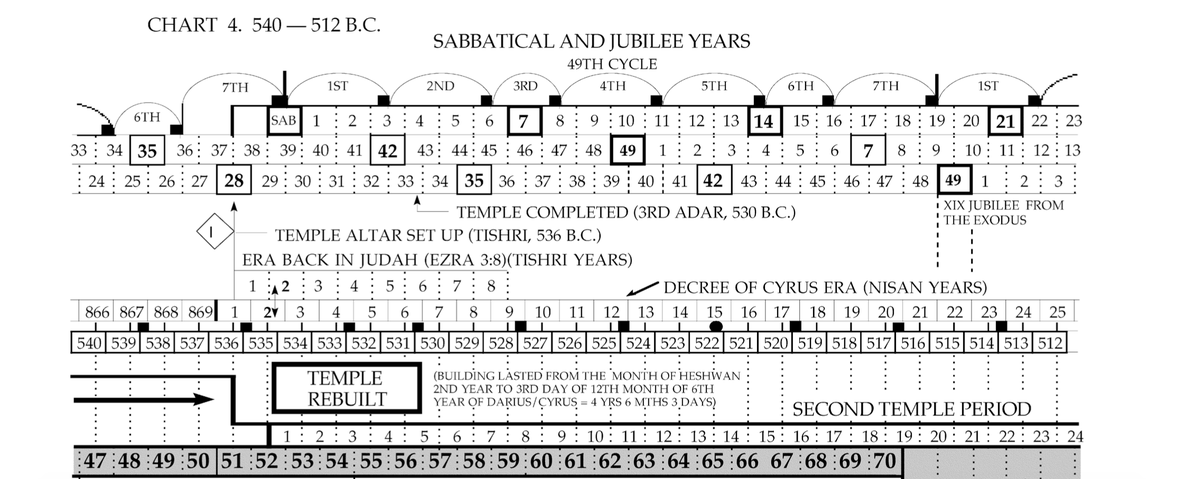TITLE: Patterns and Coherency in Biblical Dates
SUB-TITLE: (Far) Too Long in #Lockdown
SUB-SUB-TITLE: A picture paints a thousands words. (See below.)
For those who have questions, please scroll down.

In my opinion at least, more people should get involved in it,
and more people should know about its results,
many of which owe to the tireless efforts of Rodger Young (rcyoung.org/papers.html):

We’ll start with a consideration the Bible’s year-stamps,
i.e., references to ‘the Xth year of Y’, where Y denotes an era of some kind.
First up, then, the Antediluvians.
Scripture’s first year-stamp is found in Genesis 8,
where the flood is said to occur in the 600th year of Noah’s life (cp. Gen. 7.11 w. 8.4, etc.).
The lifetime of Noah is hence treated as a kind of ‘era’, which seems a natural course of action.
The Bible’s next year-stamp is found in Exodus 12.
By the time they leave Egypt, the Israelites are said to have sojourned there for 430 years,
P.S. Let’s not worry about Galatians 3 for now. We’ve got enough on our plate already.
Previously, it would have been natural for the Israelites to view the year in terms of an agricultural cycle (from Tishri to Tishri).
hence Ugarit’s coronation ritual took place in autumn.
against the backdrop of which a new year is defined (12.2, 13.4, etc., Deut. 16.1).
which explains what we find in 1 Kgs. 6, where Solomon is said to start work on the Temple in the 480th year since the exodus.
akin to the letters ‘AD’ in the expression ‘70 AD’ (cp. Exod 16.1, 19.1, Num. 1.1, 9.1, 33.38, 1 Kgs 6.1).
Next, we come to the book of Judges.
The text of Judges mentions a number of rulers’/judges’ reigns, both inside and outside of Israel.
Its chronological indicators, however, are significant for at least two reasons.
yet, as we’ve noted, Solomon began to build the Temple in the 480th year of the exodus era (1 Kgs. 6.1),
which shouldn’t surprise us.
The book of Judges records the history of a disintegrated nation.
No monarchy exists in the judges’ days.
And, as we’ll see, Samson’s judgeship can be shown to have overlapped with a number of other judgeships,
Indeed, one of Samson’s distinctives is his relative isolation and propensity to operate as a lone agent.
If regnal years are to serve as a calendar, a nation needs an established centre of authority and administration,
which Israel lacks in the days of the judges.
In chs. 3–8, we’re provided with little if any background information about Israel’s judges (e.g., the name of their father, their place of birth and burial, etc.),
We’re told the duration of each judges’ career.
We’re provided with information about judges’ descendants and/or place of burial.
Ehud, for instance, seems unlikely to have ruled Israel for the entire duration of the 80 years of quiet he establishes.
Certain judges must, therefore, be omitted from the book’s earlier narratives.
In addition, we have a more dense/detailed record of Israel’s judgeships.
(Perhaps later records were more detailed in the first place, or perhaps later records were just better preserved.)
As a result, judges succeed one another.
Ibzan is said to judge Israel for 7 years ‘after’ Jephthah has died;
Elon is said to judge Israel for 10 years ‘after’ Ibzan has died;
News of a judge’s death therefore appears to have been circulated among the Israelites so another judge could (somehow) be selected to take his place.
which is as one would expect, and which we’ll look at next time round.
THE END (FOR NOW).







